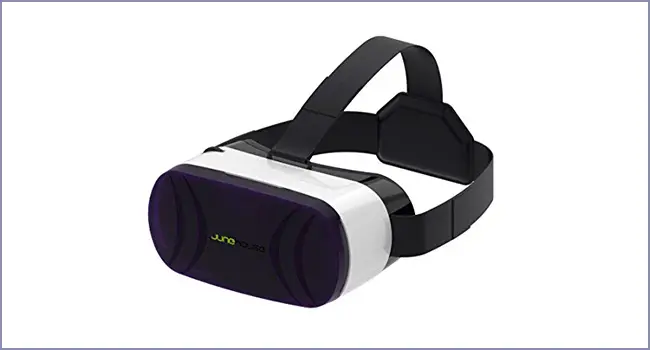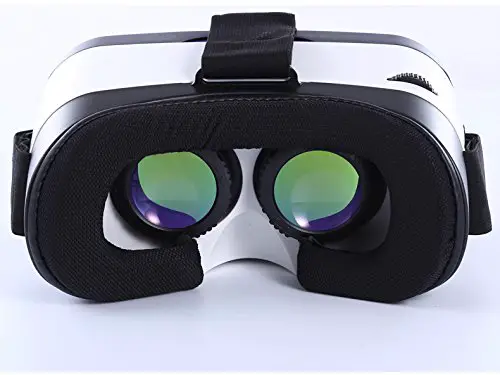Table of Contents
*This post may contain affiliate links. As an Amazon Associate we earn from qualifying purchases.
The Junehouse virtual reality headset is a budget-friendly virtual reality solution that supports a wide array of Android and iOS phones. Since it works with all major smartphones between 4.7-6″, the JJUNEHOUSE headset is probably compatible with whatever mobile device you have sitting in front of you. Perhaps it’s most notable feature is the green-tinted lenses, which block out a lot of the light spectrum that irritates people when using VR headsets for long periods of time.
The manufacturer claims this provides additional protection for users. We were interested in evaluating their unusual claims, so we decided to review the product ourselves and share our findings with the world.
Junehouse Virtual Reality Headset: Specs
| Junehouse VR Headset Specs | |
| Headset Type | Passive Google Cardboard Device |
| Resolution | 720 HD |
| Field of View | 110° |
| Sensors | None |
| Controls | Bluetooth Remote and 800° Myopia Dial |
| Platform | Android and iOS Phones |
| Amazon Rating (out of 5) | 4.5 |
| Our Rating (out of 5) | 4 |
While the Junehouse headset technically uses the Google Cardboard design blueprints, it’s actually compatible with many other VR apps. Some users have said that they prefer to keep it around as a backup VR headset for that reason. They use it if they’re having problems with their primary premium VR unit. Since it features a standard Bluetooth controller, you can reliably use it to play games or watch movies without picking your phone out of the front dock.
The green lenses really do block out a lot of the most irritating spectra of light from the headset, but it doesn’t change the color of the image you’re seeing at all. Some users are afraid that it might actually turn their movies green, but this didn’t actually seem to be the case when tested. You won’t notice the difference, but you might feel less fatigue than you usually would have.
Pros & Cons
Pros:
[su_list icon=”icon: plus-circle” icon_color=”#23a006″]
- Features a front vent to keep your smartphone from getting too hot
- Green lens coatings cut down on the amount of blue light coming from your device
- Full compatibility with all Google Carboard VR apps and partial compatibility with many others
- Supports a wide array of smartphones
[/su_list]
Cons:
[su_list icon=”icon: minus-circle” icon_color=”#a00e06″]
- Doesn’t support Windows Phone
- Completely passive design features few onboard controls
- Headstrap design sometimes has an awkward fit
[/su_list]
Junehouse Virtual Reality Headset: Design & Requirements

[su_button url=”https://www.amazon.com/JUNEHOUSE-Virtual-Smartphones-Bluetooth-Touchpad/dp/B01MF84B2F/?tag=probestvr.com-20″ target=”blank” style=”flat” background=”#f40616″ size=”6″ center=”yes” radius=”0″ rel=”nofollow”]Check Prices[/su_button]
The Junehouse VR headset should support Android phones from any vendor that are somewhere between 4.7-6″ long, though it sometimes struggles with phones that are extremely lopsided. Some Android phones with massive cameras are rather heavy on one side, which can make wearing the Junehouse a bit of a challenge. Otherwise, though, you shouldn’t have any issues.
While you’ll more than likely not be able to get the Bluetooth remote to work with iOS devices very well, it should support any iPhone between these sizes. Apple users shouldn’t have any problems related to weight either due to the way that iPhones are designed. Your phone should snap tight in the front docking bay. Most users don’t have any issues with their phones falling out during use either.
Junehouse Virtual Reality Headset: Controls & Display
Most users won’t have to adjust any controls to get their image to focus, but those with myopia should be able to turn a couple of dials to alter the image up to 800° without distorting it. It’s actually possible to turn these dials beyond this point, but doing so will cause you to see two independent pictures again.
If you need to adjust it, then it’s easy enough to do so using the default Google Cardboard test movie featuring a pair of Tiki masks. Once you get the image in focus you should see an image with a fairly wide field of view, which is actually typical of Cardboard clones.
Junehouse Virtual Reality Headset: Setup
The Junehouse VR unit features a completely passive design using little more than lenses and mechanical dials, which means you won’t have to worry about assembling anything. You can take the product out of its case, install Google’s Cardboard app on your phone and start to watch 3D VR movies right away. All you’ll need to do is tie in the head strap, which some users have complained is a bit difficult. Junehouse recently improved some aspects of the manufacturing process, so this shouldn’t be as much of a problem now as it was in the past.
Junehouse Virtual Reality Headset: User Experience
One user remarked that they enjoyed the Junehouse VR headset, but that they were disappointed with the fact that they struggled to use the phone’s touchscreen system while it was docked. Another felt that this wasn’t an issue at all, but they recommended getting a new Bluetooth controller for gaming.
A third user actually said that it’s such a fun headset that they wished they had got one before. It seems like all three agreed that the one place the unit was lacking in was proper documentation.
Bottom Line
While it might not have the best directions, it’s easy enough to figure out how to configure the Junehouse VR headset without too much work. It’s a fun beginner’s unit or perhaps a good second headset if you already own a different model and want a backup.
If you’ve ever tried the Junehouse VR unit, then we’d love to hear about your experience. Keep following us for more reviews of new virtual reality technology.

